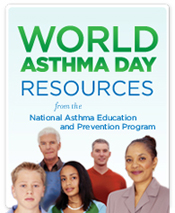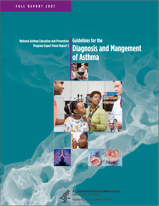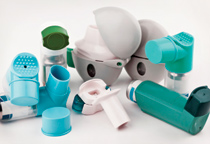- Volume 9 | Spring-Summer 2012
- Not on our list? Subscribe now!
Breaking News
Millions of Americans Learn About Asthma Control Thanks to World Asthma Day and Asthma Awareness Month
A potential 85 million listeners, more than 7 million readers, and hundreds of webinar participants: Those are just the preliminary estimates of how many people were reached by the National Asthma Education and Prevention Program’s (NAEPP) World Asthma Day and Asthma Awareness Month (May) efforts to highlight written asthma action plans as part of a comprehensive approach to improving asthma care and control, especially for those bearing the greatest burden.

The NAEPP is coordinated by the National Heart, Lung, and Blood Institute of the National Institutes of Health. The NAEPP's clinical practice guidelines recommend that all patients with asthma—particularly those with moderate and severe asthma, a history of asthma attacks, or poorly controlled asthma—receive a written, tailored asthma action plan from their health care provider. A written asthma action plan provides asthma patients with instructions and information on how to self-manage their asthma daily, including taking medications appropriately, and identifying and avoiding exposure to allergens and irritants that can bring about asthma symptoms. In addition, asthma action plans provide information on how to recognize and handle worsening asthma, and when, how, and who to contact in an emergency.
The NAEPP’s diverse and far-reaching educational push during May included distribution of key information and resources through an array of channels. Specific activities included engaging NAEPP Coordinating Committee members and other asthma stakeholders in disseminating key messages about asthma care and control; producing and pitching a news article, “Six Actions to Control Asthma,” to community-level media; approaching individual top-tier members of the media with news about asthma action plans and offering expert interviews on asthma; hosting two webinars; and posting a World Asthma Day Web page to share resources.
In a mere three weeks, the “Six Actions to Control Asthma” news article was picked up by 25 news outlets from states across the country, from Alaska to Georgia, potentially reaching more than 7 million readers. This outreach continues.
Many million more were reached by the following two radio interviews:
GIP in Focus
What a Difference a Year Makes!

Changes Lead to More Than Twice as Many Patients with Asthma Receiving Optimal Care in 49 Pediatric Practices
The National Asthma Education and Prevention Program’s (NAEPP) clinical practice guidelines provide a road map for quality asthma care. To improve asthma outcomes, increasing adherence to the guidelines’ evidence-based recommendations is a must.
That’s why the NAEPP gleaned from these guidelines six key actions that health care providers, patients, families and caregivers of patients, and other asthma stakeholders can take together to improve asthma care and control.
To increase the number of pediatric practices taking the six actions and following the NAEPP guidelines, the American Academy of Pediatrics (AAP) launched a yearlong study to see whether a quality improvements program that incorporates these messages would make a difference.
Asthma Research into Action
Show and Tell: Teaching Children with Asthma How To Use Asthma Devices
Betsy Sleath, Ph.D., a sociologist with a background in pharmacy, first became interested in asthma when her daughter was six years old and would have friends sleep over at their home.
 Dr. Betsy Sleath and her daughter
Dr. Betsy Sleath and her daughter“Before they came over we had to think carefully about how to prepare, because we have cats and dogs and pet dander is a potential trigger for an asthma attack,” said Dr. Sleath of the UNC Eshelman School of Pharmacy. “The girls’ mothers were knowledgeable about their children’s asthma, but it led me to realize that we need to teach children how to manage their disease at a young age in case mom or dad is not around.”
Having witnessed her own mother manage diabetes daily, Dr. Sleath was steeped in chronic disease management from an early age herself. This is what triggered her interest in examining what role communication plays in the management of chronic diseases and what ultimately led her and a group of colleagues to explore whether children with asthma were using various asthma devices properly.
What they found is disheartening.
Partner Profile
Continuing Education: Critical to Quality Asthma Care
“Even if you’re a very experienced clinician and see children with asthma daily, you still need education on the ever-changing medications and latest gadgets,” said Dolores C. Jones, Director of Practice, Education, and Research at the National Association of Pediatric Nurse Practitioners (NAPNAP).

Taking medication as prescribed by a health care provider—typically, an inhaled corticosteroid for daily, long-term control and a short-acting beta2-agonist for quick relief of symptoms—is one of several actions included in a written asthma action plan. And having such a plan is one of six key actions that the National Asthma Education and Prevention Program (NAEPP) is encouraging people with asthma and their families to take together with their clinician.
The very first step, however, is to be aware of which medications are most effective and best suited to a patient’s needs and preferences.

















 Twitter
Twitter
 Facebook
Facebook YouTube
YouTube